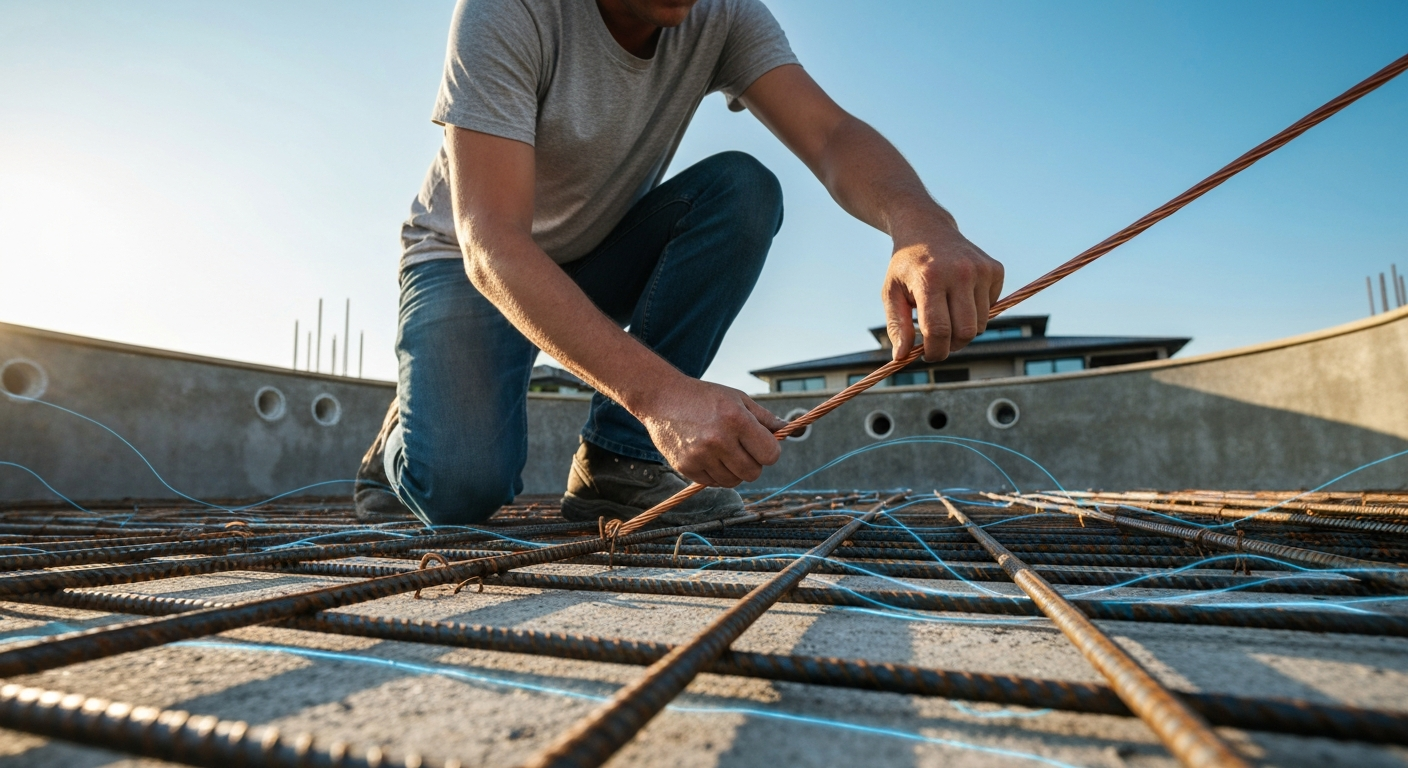
Equipotential Bonding: Pools, Spas, and Wet Areas per NEC 2023
Equipotential Bonding vs. Grounding: Decoding NEC 2023 for Pools and Wet Areas
Imagine a perfect summer day. The sun is out, the grill is going, and the pool is sparkling. It’s a scene of relaxation, but beneath the surface—literally—lies a complex electrical environment that demands the highest level of safety. With the U.S. swimming pool construction market being a multi-billion dollar industry, ensuring these installations are safe is more critical than ever for licensed electricians. Stray currents, invisible to the eye, can create dangerous conditions. This is where the principles of the nec 2023 grounding and bonding requirements, particularly those in NEC Article 680, become a life-saving blueprint.
The latest edition of the National Electrical Code brings new clarity and expanded rules for pools, spas, and other wet areas. For electrical professionals, mastering these requirements isn’t just about compliance; it’s about protecting lives from hazards like voltage gradient differences, which can lead to severe electric shock. This article breaks down the essential updates, clarifies the vital distinction between bonding and grounding, and explains the “why” behind these critical safety measures.
The Fundamental Difference: Grounding (Article 250) vs. Bonding (Article 680)
As a seasoned electrician, you’re well-versed in the principles of NEC Article 250, the cornerstone of system and equipment grounding. Its primary job is to create a safe, effective ground-fault current path so that a breaker will trip or a fuse will blow during a fault. However, when working around water, the rules of NEC Article 680 introduce a different, equally important concept: equipotential bonding.
The sole purpose of equipotential bonding is to connect all conductive surfaces and equipment in and around a pool to create an equipotential plane. This ensures every metallic part—from the rebar in the concrete to the pump motor and handrails—is at the same electrical potential. Why is this so crucial? In a wet environment, a person is far more susceptible to electric shock. By eliminating voltage differences between objects, equipotential bonding protects swimmers from two specific dangers: step and touch potential. Even a small voltage difference that might be unnoticeable in a dry setting can be deadly in a pool.
Decoding NEC Article 680: Key Changes and Focus Areas for 2023
The 2023 NEC refines and expands on previous requirements, placing a stronger emphasis on comprehensive safety. The industry trend toward enhanced electrical protection is mirrored in the new code.
Expanded GFCI Protection
One of the most significant changes is the expansion of GFCI protection. Previous codes targeted specific receptacles and equipment, but the 2023 NEC now mandates GFCI protection for virtually all electrical equipment related to the pool. This includes pumps, heaters, and lighting circuits operating at various voltages, reflecting a major step forward in personnel safety. For instance, NEC 2023 requires GFCI protection on outlets supplying pool motors, receptacles within 20 feet of the pool walls, and other specific pool equipment.
The Equipotential Bonding Grid: Your Foundation of Safety
The heart of pool safety is the equipotential bonding grid. This isn’t just a single wire; it’s a comprehensive system designed to place everything on the same electrical plane. The key components include:
- An 8 AWG Copper Conductor: This is the backbone of the grid. NEC 680.26(C) requires the common bonding grid conductor to be a solid copper conductor (which can be insulated, covered, or bare) no smaller than 8 AWG. The requirement for a solid conductor ensures durability and a reliable, low-impedance path, especially where it is buried or encased in concrete.
- Conductive Pool Shells: For concrete or gunite pools, the reinforcing steel (rebar) grid within the shell must be bonded to become part of the equipotential plane.
- Perimeter Surface Bonding: This is a critical and often misunderstood requirement. The 2023 NEC clarifies that a bonding grid must extend 3 feet horizontally from the inside walls of the pool. This applies to both paved (like concrete decks) and unpaved surfaces, creating a “safe zone” for anyone walking around the pool. For unpaved surfaces where reinforcing steel is not available, alternative methods such as a buried copper ring or grid must be used per NEC 680.26(B)(2).
- All Accessible Metallic Parts: The code is explicit: any fixed metallic parts within 5 feet horizontally of the pool and within 12 feet vertically of the maximum water level must be bonded. This includes ladders, handrails, diving boards, metal fences, and even metal window and door frames.
Special Focus on Wet-Niche Luminaires
Underwater lighting fixtures, or wet-niche luminaires, receive special attention due to their direct contact with water. These fixtures require both robust bonding of their forming shells and grounding via an equipment grounding conductor (EGC) to ensure multiple layers of protection against faults.
Why It Matters: Understanding Voltage Gradients, Step, and Touch Potential
To truly appreciate the importance of these rules, it’s essential to understand the hazards they prevent. A voltage gradient is a difference in electrical potential across a distance. Imagine a fault energizing the ground near a pool. The voltage will be highest near the fault and decrease as you move away from it. This gradient creates two life-threatening scenarios:
- Step Potential: The voltage difference between a person’s two feet as they take a step. If one foot is in an area of higher voltage than the other, current can flow up one leg and down the other.
- Touch Potential: The voltage difference between a person’s hand touching an object (like a metal ladder) and their feet on the ground or in the water. If the ladder and the ground are at different potentials, a dangerous current can pass through the person’s body.
By creating an equipotential plane, proper bonding ensures that the ladder, the deck, the water, and all other conductive parts rise to the same potential during a fault. This eliminates the voltage differences that cause step and touch potential, much like how a bird can safely sit on a high-voltage wire because it’s only touching one point.
Differentiating Roles: EGC, Main Bonding Jumper, and System Bonding Jumper
While the 8 AWG solid copper conductor creates the equipotential grid, it’s crucial not to confuse its role with that of the equipment grounding conductor (EGC). The EGC’s job, as defined in NEC Article 250, is to provide an effective ground-fault current path from the equipment back to the source, allowing the overcurrent device to operate. The equipotential bonding conductor for a pool is not required to be connected back to the panelboard or service equipment.
The EGC works as part of the larger electrical system, which includes the main bonding jumper at the service and the system bonding jumper at a separately derived system. These jumpers are what ultimately connect the equipment grounding system to the grounded (neutral) conductor, completing the path for fault current. While these principles apply universally, understanding how they adapt to different environments is key. For example, grounding and bonding requirements in Class I hazardous locations have their own unique set of rules under the NEC.
Correctly sizing all conductors in this system is non-negotiable. To learn more about recent updates in this area, you can explore the significant changes to Grounding Electrode Conductor (GEC) sizing rules in the 2023 NEC.
Conclusion: Upholding Safety in a Growing Market
The updates to nec 2023 grounding and bonding requirements in Article 680 underscore a clear industry mandate: safety in wet environments is paramount. With the rise of automated pool systems and increasingly complex electrical loads, a deep understanding of these rules is a non-negotiable aspect of a modern electrician’s expertise. From the proper installation of an equipotential plane to the expanded use of GFCI protection, every detail matters.
For licensed electricians, mastering these code requirements is more than a professional obligation—it’s a commitment to public safety. As you tackle your next pool, spa, or fountain project, ensure your work not only meets but exceeds the standards set forth by the NEC. Stay ahead of the curve and ensure your installations are safe and compliant. To deepen your understanding of the latest code cycle, browse our courses and keep your skills sharp.
Frequently Asked Questions (FAQ)
Is the equipotential bonding conductor the same as the equipment grounding conductor (EGC)?
No. The equipotential bonding conductor (typically an 8 AWG solid copper wire) connects all metallic parts around a pool to create an equipotential plane and prevent dangerous voltage gradients. The EGC provides a path for fault current to return to the source to trip a breaker. The bonding grid is not required to be connected back to the service panel.
Does an above-ground pool with a vinyl liner need equipotential bonding?
It depends on the type of pool. The NEC makes a distinction between “permanently installed” pools and “storable” pools. A permanently installed above-ground pool, even with a non-conductive liner, requires the same comprehensive equipotential bonding as an in-ground pool under NEC 680.26. This includes bonding the metallic structural components, electrical equipment, perimeter surface, and the pool water itself. However, storable pools (designed to be disassembled and stored) fall under different rules in NEC Part III, which do not require the same extensive equipotential bonding grid.
Why is the conductor required to be a solid 8 AWG copper wire?
NEC 680.26(C) specifies a solid copper conductor no smaller than 8 AWG for the common bonding grid. “Solid” is specified for its mechanical strength and durability when buried or encased in concrete. Copper is mandated for its high conductivity and excellent corrosion resistance, which are essential for a long-lasting safety system in a wet and often chemically-treated environment.
Disclaimer: The information provided in this educational content has been prepared with care to reflect current regulatory requirements for continuing education. However, licensing rules and regulations can vary by state and are subject to change. While we strive for accuracy, ExpertCE cannot guarantee that all details are complete or up to date at the time of reading. For the most current and authoritative information, always refer directly to your state’s official licensing board or regulatory agency.



